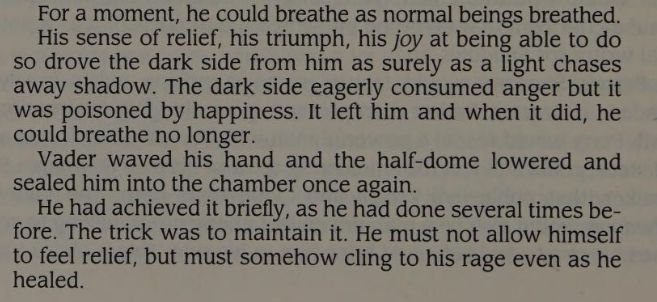In The Rise of Skywalker, we see Force healing used multiple times by Light Side users. Rey heals a wounded creature and later saves Ben Solo’s life, making it seem like a natural Jedi ability. But this raises an important question.
In The Clone Wars Mortis arc, Anakin uses Force healing to bring Ahsoka back from death. Yet, after his duel on Mustafar—when he was left burned, broken, and barely alive—why didn’t he use this ability to heal himself?
As it turns out, Vader could use Force healing. But he ultimately stopped using it forever.
Let me explain.
1. Force Healing Is Exclusive to the Light Side
The reason we never see Darth Vader—or any other Sith Lords—using Force healing is because it’s a power tied to the light side.
When we look at Star Wars: Force and Destiny – Disciples of Harmony, it becomes clear why Vader could never heal himself using the Force. The book explains that while many can treat wounds, true Force Healers go beyond just curing injuries—they tap into the Force to bring comfort and aid, seeking out the root cause of suffering, even if that cause is tied to the dark side itself.
“Others are also skilled at treating injuries, reducing symptoms, and mending wounds. But only the Healer uses the Force to provide comfort and aid to those who need it most.”
That’s the key difference. Healing in the Force is about selflessness—about reaching out to help others without expectation. But Vader’s entire existence was the opposite of that. His power came from anger, pain, and destruction. The dark side isn’t about restoration—it’s about domination. Even though some Sith experimented with ways to prolong life or cheat death, their methods were unnatural, twisted, and never truly healing.
Since true healing is tied to the light side, Sith Lords who sought to prolong their lives or restore their strength turned to a much darker method—Force Drain. Instead of mending wounds or rejuvenating the body, Force Drain allows a dark side user to steal life energy from others, replenishing their own power at the cost of another’s suffering.
“The art of healing, as well as harming with the Force, was of particular note to the Sith Lords.”
We see this in ancient Sith Lords like Darth Nihilus, whose insatiable hunger for life energy became so overwhelming that he could consume entire planets. Unlike Jedi Healers, who seek to restore balance, Sith sees life itself as something they can take, twist, and corrupt for their own survival.
This is why we don’t see Vader heal—because the Sith didn’t heal. They stole. They consumed. If Vader ever wanted to regain strength, it wouldn’t be through healing meditation or Bacta therapy—it would be through draining another being’s life force.
2. Vader Could Heal Himself, But Only If He Never Felt Relief
Yes, Darth Vader could actually use Force healing—or at least, he understood the ability. If we look back at the Mortis arc in The Clone Wars, Anakin himself used Force healing to bring Ahsoka back from death. That alone tells us that Anakin, and by extension Vader, knew how it worked.
However, Star Wars: Shadows of the Empire reveals that Vader was capable of healing himself—but only under one condition. He had to be fully immersed in the dark side, channeling rage and suffering.
As I mentioned earlier, Force healing is a light side ability. While Vader understood it, he couldn’t use it without embracing the very emotions that the dark side rejects. True Force healing comes from letting go of pain, anger, and hatred—something Vader couldn’t afford to do.
From the book, we see that Vader actively tried to heal himself:
“The following is an excerpt from Perry’s novel chronicling both a hyperbaric chamber session and the Dark Lord’s effort to will himself to health, unencumbered by the machinery of healing.”
The passage even describes his healing process in detail:
“He sat exposed to the surrounding room, unprotected by the super-medicated and oxygenated field inside the chamber. He concentrated on the injustice of his condition, on his hatred of Obi-Wan who had made him so. With the anger and hatred, the dark side of the Force permeated Vader.”
And for a brief moment, it actually worked:
“For a moment, his ruined tissues altered, his scarred lungs and dead alveoli and constricted passages smoothed out and became whole.”
This proves that Vader’s body could repair itself, even allowing him to breathe normally without his suit. But the moment he felt relief or joy, the healing stopped.
“His sense of relief, his triumph, his joy at being able to do so drove the dark side from him as surely as a light chases away shadow.”

That’s the dark side’s greatest flaw—it thrives on pain and suffering. If Vader allowed himself to feel any positive emotion, his connection to the dark side weakened, and with it, his ability to sustain his healing.
“He must not allow himself to feel relief, but must somehow cling to his rage even as he healed.”
In the end, we can see that Vader was trapped in a paradox—he could heal, but only by embracing endless suffering. True recovery meant letting go of his pain, but if he did, he would lose the very power that defined him. And so, he remained broken, both in body and spirit, bound to the dark side until the very end.

